SCS-C02 Amazon Web Services AWS Certified Security - Specialty Free Practice Exam Questions (2025 Updated)
Prepare effectively for your Amazon Web Services SCS-C02 AWS Certified Security - Specialty certification with our extensive collection of free, high-quality practice questions. Each question is designed to mirror the actual exam format and objectives, complete with comprehensive answers and detailed explanations. Our materials are regularly updated for 2025, ensuring you have the most current resources to build confidence and succeed on your first attempt.
A security engineer is configuring AWS. Config for an AWS account that uses a new 1AM entity When the security engineer tries to configure AWS. Config rules and automatic remediation options, errors occur in the AWS CloudTrail logs the security engineer sees the following error message "Insufficient delivery policy to s3 bucket DOC-EXAMPLE-BUCKET, unable to write to bucket provided s3 key prefix is 'null'."
Which combination of steps should the security engineer take to remediate this issue? (Select TWO.)
A security engineer configures Amazon S3 Cross-Region Replication (CRR) for all objects that are in an S3 bucket in the us-east-1. Region Some objects in this S3 bucket use server-side encryption with AWS KMS keys (SSE-KMS) for encryption at test. The security engineer creates a destination S3 bucket in the us-west-2 Region. The destination S3 bucket is in the same AWS account as the source S3 bucket.
The security engineer also creates a customer managed key in us-west-2 to encrypt objects at rest in the destination S3 bucket. The replication configuration is set to use the key in us-west-2 to encrypt objects in the destination S3 bucket. The security engineer has provided the S3 replication configuration with an IAM role to perform the replication in Amazon S3.
After a day, the security engineer notices that no encrypted objects from the source S3 bucket are replicated to the destination S3 bucket. However, all the unencrypted objects are replicated.
Which combination of steps should the security engineer take to remediate this issue? (Select THREE.)
A company hosts a web-based application that captures and stores sensitive data in an Amazon DynamoDB table. The company needs to implement a solution that provides end-to-end data protection and the ability to detect unauthorized data changes.
Which solution will meet these requirements?
A company has deployed Amazon GuardDuty and now wants to implement automation for potential threats. The company has decided to start with RDP brute force attacks that come from Amazon EC2 instances in the company’s AWS environment. A security engineer needs to implement a solution that blocks the detected communication from a suspicious instance until investigation and potential remediation can occur.
Which solution will meet these requirements?
A company has two VPCs in the same AWS Region and in the same AWS account Each VPC uses a CIDR block that does not overlap with the CIDR block of the other VPC One VPC contains AWS Lambda functions that run inside a subnet that accesses the internet through a NAT gateway. The Lambda functions require access to a publicly accessible Amazon Aurora MySQL database that is running in the other VPC
A security engineer determines that the Aurora database uses a security group rule that allows connections from the NAT gateway IP address that the Lambda functions use. The company's security policy states that no database should be publicly accessible.
What is the MOST secure way that the security engineer can provide the Lambda functions with access to the Aurora database?
A company's engineering team is developing a new application that creates IAM Key Management Service (IAM KMS) CMK grants for users immediately after a grant IS created users must be able to use the CMK tu encrypt a 512-byte payload. During load testing, a bug appears |intermittently where AccessDeniedExceptions are occasionally triggered when a userfirst attempts to encrypt using the CMK
Which solution should the c0mpany‘s security specialist recommend‘?
A company has recently recovered from a security incident that required the restoration of Amazon EC2 instances from snapshots. The company uses an AWS Key
Management Service (AWS KMS) customer managed key to encrypt all Amazon Elastic Block Store (Amazon EBS) snapshots.
The company performs a gap analysis of its disaster recovery procedures and backup strategies. A security engineer needs to implement a solution so that the company can recover the EC2 instances if the AWS account is compromised and the EBS snapshots are deleted.
Which solution will meet this requirement?
A company has launched an Amazon EC2 instance with an Amazon Elastic Block Store(Amazon EBS) volume in the us-east-1 Region The volume is encrypted with an AWS Key Management Service (AWS KMS) customer managed key that the company's security team created The security team has created an 1AM key policy and has assigned the policy to the key The security team has also created an 1AM instance profile and has assigned the profile to the instance
The EC2 instance will not start and transitions from the pending state to the shutting-down state to the terminated state
Which combination of steps should a security engineer take to troubleshoot this issue? (Select TWO )
A company deployed IAM Organizations to help manage its increasing number of IAM accounts. A security engineer wants to ensure only principals in the Organization structure can access a specific Amazon S3 bucket. The solution must also minimize operational overhead
Which solution will meet these requirements?
A company stores sensitive documents in Amazon S3 by using server-side encryption with an IAM Key Management Service (IAM KMS) CMK. A new requirement mandates that the CMK that is used for these documents can be used only for S3 actions.
Which statement should the company add to the key policy to meet this requirement?
A)
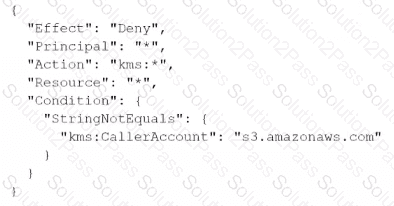
B)

A systems engineer deployed containers from several custom-built images that an application team provided through a QA workflow The systems engineer used Amazon Elastic Container Service (Amazon ECS) with the Fargate launch type as the target platform The system engineer now needs to collect logs from all containers into an existing Amazon CloudWatch log group
Which solution will meet this requirement?
A company has AWS accounts in an organization in AWS Organizations. The company requires a specific software application to be installed on all new and existing Amazon EC2 instances in the organization AWS Systems Manager Agent (SSM Agent) is installed and active on all the instances.
How can the company continuously monitor the deployment status of the software application on all the instances?
A security engineer is implementing a logging solution for a company's AWS environment. The security engineer has configured an AWS CloudTrail trail in the company's AWS account. The logs are stored in an Amazon S3 bucket for a third-party service provider to monitor. The service provider has a designated 1AM role to access the S3 bucket.
The company requires all logs to be encrypted at rest with a customer managed key. The security engineer uses AWS Key Management Service (AWS KMS) lo create the customer managed key and key policy. The security engineer also configures CloudTrail to use the key to encrypt the trail.
When the security engineer implements this configuration, the service provider no longer can read the logs.
What should the security engineer do to allow the service provider to read the logs?
A company wants to configure DNS Security Extensions (DNSSEC) for the company's primary domain. The company registers the domain with Amazon Route 53. The company hosts the domain on Amazon EC2 instances by using BIND.
What is the MOST operationally efficient solution that meets this requirement?
An AWS account includes two S3 buckets: bucket1 and bucket2. The bucket2 does not have a policy defined, but bucket1 has the following bucket policy:
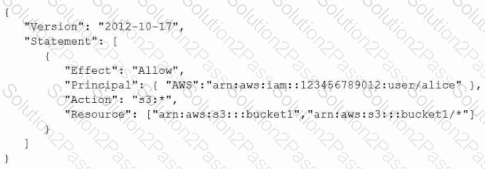
In addition, the same account has an IAM User named "alice", with the following IAM policy.

Which buckets can user "alice" access?
A company wants to ensure that its IAM resources can be launched only in the us-east-1 and us-west-2 Regions.
What is the MOST operationally efficient solution that will prevent developers from launching Amazon EC2 instances in other Regions?
A company uses identity federation to authenticate users into an identity account (987654321987) where the users assume an IAM role named IdentityRole. The users then assume an IAM role named JobFunctionRole in the target IAM account (123456789123) to perform their job functions.
A user is unable to assume the IAM role in the target account. The policy attached to the role in the identity account is:
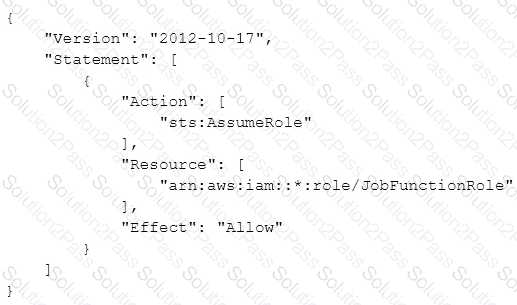
What should be done to enable the user to assume the appropriate role in the target account?
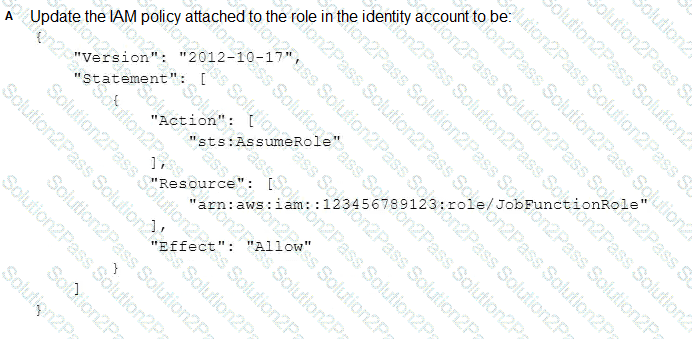
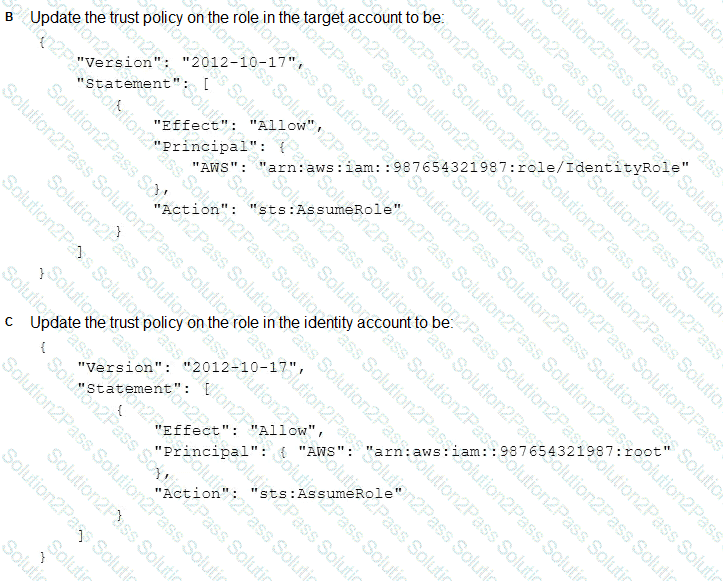
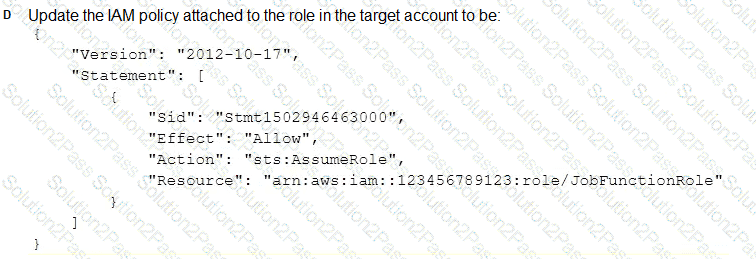
A company has enabled Amazon GuardDuty in all AWS Regions as part of its security monitoring strategy. In one of its VPCs, the company hosts an Amazon EC2 instance that works as an FTP server. A high number of clients from multiple locations contact the FTP server. GuardDuty identifies this activity as a bruteforce attack because of the high number of connections that happen every hour.
The company has flagged the finding as a false positive, but GuardDuty continues to raise the issue. A security engineer must improve the signal-to-noise ratio without compromising the companys visibility of potential anomalous behavior.
Which solution will meet these requirements?
A Security Engineer is asked to update an AWS CloudTrail log file prefix for an existing trail. When attempting to save the change in the CloudTrail console, the
Security Engineer receives the following error message: `There is a problem with the bucket policy.`
What will enable the Security Engineer to save the change?
A company wants to deploy a distributed web application on a fleet of EC2 instances. The fleet will be fronted by a Classic Load Balancer that will be configured to terminate the TLS connection The company wants to make sure that all past and current TLS traffic to the Classic Load Balancer stays secure even if the certificate private key is leaked.
To ensure the company meets these requirements, a Security Engineer can configure a Classic Load Balancer with:
